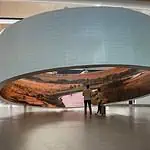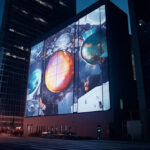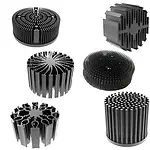Transparent LED screens are the most attractive way to display. They have taken the advertising sector to a different level. But have you ever wondered what makes them transparent?
The transparent LED display screens are an advanced version of standard LED screens. It is a type of display technology that uses transparent materials to create a vivid and vibrant image. And thus, it engages the audience with the content in the most attractive way possible. Besides, they are cost-effective and easy to maintain. So, they are excellent for commercial and advertising purposes.
In this blog post, Let’s explore what transparent LED screens are and how they work. Additionally, you can look at the potential benefits they offer visuals world. Let’s dive in!
What is a Transparent LED Screen?
A transparent LED screen is a display technology that uses light-emitting diodes (LEDs) to produce an image. The light emitted from the LEDs is projected onto a transparent surface. And this transparency allows visibility from both sides of the screen.
Transparent LED Screens are perfect for interactive displays. And they indeed make a lasting impression on any audience. Besides, these screens are also energy-efficient. And they are an attractive solution for businesses. You can use them on billboards, showrooms, and other public venues for advertisement/display.
For more information about LED display, you can check A Comprehensive Guide to LED Display and Top 10 Transparent LED Screen Manufacturers and Suppliers in China (2024).

How Do Transparent LED Screens Work?
Transparent LED screens combine LED backlights and transparent LCD glass. This combination allows the light from the LEDs to pass through the LCD glass. It results in a bright, clear image that appears to be floating in mid-air.
The LEDs in transparent LED screens are arranged in a matrix and are driven by a controller. This controller sends signals to each individual LED. Thus, it forms different images on the screen.
Furthermore, transparent LED screens have up to millions of tiny LEDs (light-emitting diodes). These LEDs sandwich between two layers of film. The top layer is transparent to allow light to pass through. However, the bottom layer is reflective to reflect the light toward the viewer’s eyes. LEDs emit light that has different colors and brightness levels. They combine to create images and videos.
Also, transparent LED screens have a wide viewing angle. As a result, viewers can see the image from any angle without distortion or blurriness. Besides, the LEDs behind the image or video are turned off while those in front remain lit. This makes it appear as though the display is transparent and allows viewers to see through it.
How Are Transparent LED Screens Constructed?
Transparent LED screens are constructed from a combination of unique materials and components. The core of the construction is two layers of glass. These are treated with an anti-glare and anti-reflective coating. And it allows the display to be seen clearly, even in direct sunlight. In addition, a thin layer of the transparent LCD panel is placed between these two layers of glass. This transparent LCD panel contains thousands of pixels. It can be lit up independently by LEDs.
The LEDs are mounted on the rear of the display, with a layer of light diffusers on top. This helps spread the light from the LEDs evenly across the screen. On top of that, a layer of polarizers helps control the light’s brightness and color. Finally, a transparent plate covers the entire structure. Then it creates a seamless, vibrant image without any visible seams or edges.
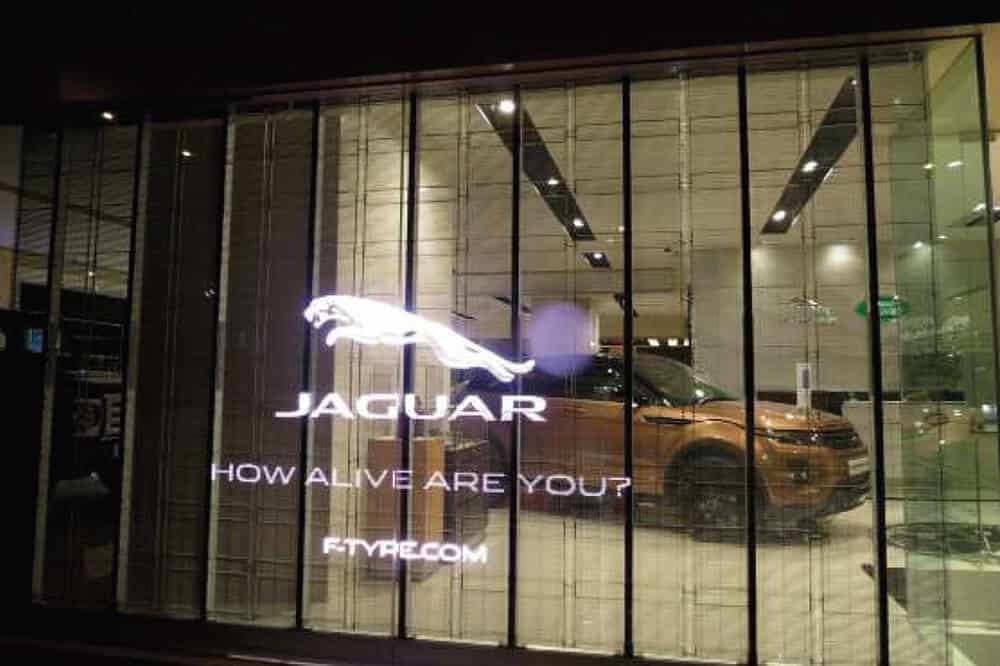
Features & Benefits of Transparent LED Screen
Transparent LED screens are an excellent option for commercial display purposes. The feature and benefits of these screens are as follows:
Increased Visibility
Transparent LED screens allow for greater visibility and depth of the field. It makes it effortless to capture your audience’s attention. Moreover, transparent LED screens offer better image quality. It also delivers higher contrast and sharpness, providing a crisp image.
Durability
These screens are highly durable and can withstand harsh weather conditions. This makes them excellent for both indoor and outdoor use. Besides, transparent LEDs have a lifetime of up to 10 years. This makes them an excellent long-term investment for businesses and homes alike.
Energy-Efficient
Transparent LED screens consume less energy than traditional LED displays. It helps you to reduce your carbon footprint.
Brightness
Transparent LED screens are bright enough for daylight. They have higher brightness settings than traditional LCDs or plasma displays. This makes them ideal for outdoor use in direct sunlight.
Versatile and Cost-effective
Transparent LED screens have high transparency rates and adjustable brightness settings. They can display images, videos, and information in virtually any environment. Transparent LED screens are cost-effective. They are affordable compared to traditional display technologies.
Easy Installation
Transparent LED screens are effortless to install. They do not require any complicated wiring or hardware setup. The slim design also makes them easy to mount on walls and ceilings. It allows you to set up your display quickly and easily.

Types of Transparent LED Screens
Transparent LED screens are an innovative way to bring any space to life. Many types of transparent LED screens have a variety of applications.
Transparent OLED
OLED stands for Organic Light Emitting Diode. It is the latest technology allowing transparent display materials. Moreover, it permits light to pass through the display and remain visible. Thus, a transparent OLED creates interactive displays. And this makes the user experience more immersive and engaging.
Transparent LCD
A transparent LCD is a special type of liquid crystal display. This lets the user view an image while allowing light to pass through. Besides, they have many applications, ranging from advertising to medical imaging. In addition, they provide a unique way of displaying information with the transparency of glass.
Side-Lighting Transparent LED Display
A side-lighting transparent LED display is digital signage technology. It uses light-emitting diodes (LEDs) to create vibrant, eye-catching visuals. This type of display has a layer of transparent material, such as acrylic or polycarbonate. Unlike traditional displays, this gives a much brighter and more vivid appearance.
Therefore, it is ideal for applications where visibility and impact are essential. This display type is perfect for indoors and outdoors thanks to its design. Also, it can stand up to harsh weather conditions.
Front-Lighting Transparent LED Display
Front-lighting transparent LED displays are made up of transparent panels. It has embedded LED lights that shine through the front side of the panel. This type of display provides an impressive and captivating light show. You can use it for advertisements, promotions, and events. Also, you can adjust the brightness to create the desired effect. Plus, it is more energy efficient than traditional displays. As a result, it requires less power to achieve maximum brightness. Front-lighting transparent LED displays will make any advertisement or event stand out from the crowd!
GOB Transparent LED Display
GOB is an onboard gluing technology for obtaining high-protection transparent LED screens. It uses transparent glue to seal the module surface. And thus, it extends the screen’s lifespan due to the controlled LED heat dispassion. This glue-on-board technology provides the LED display maximum protection from dropping or hitting.
COB Transparent LED Display
COB stands for Chip-On-Board. In this technology, multiple LED chips are bonded together to form a single module. The compact arrangement of the chips only takes up a little space. As a result, they vastly reduce the size compared to traditional screens. COB transparent LED screens have high light efficiency and a wider viewing angle.
Laminating Transparent LED Display
Laminating transparent LED displays is a modern display technology. It combines the benefits of traditional LED displays with a translucent screen. This type of display gives a high-quality viewing experience. As people can see from both sides, it has excellent clarity and brightness. Furthermore, this type of display is highly energy-efficient and requires minimal maintenance.
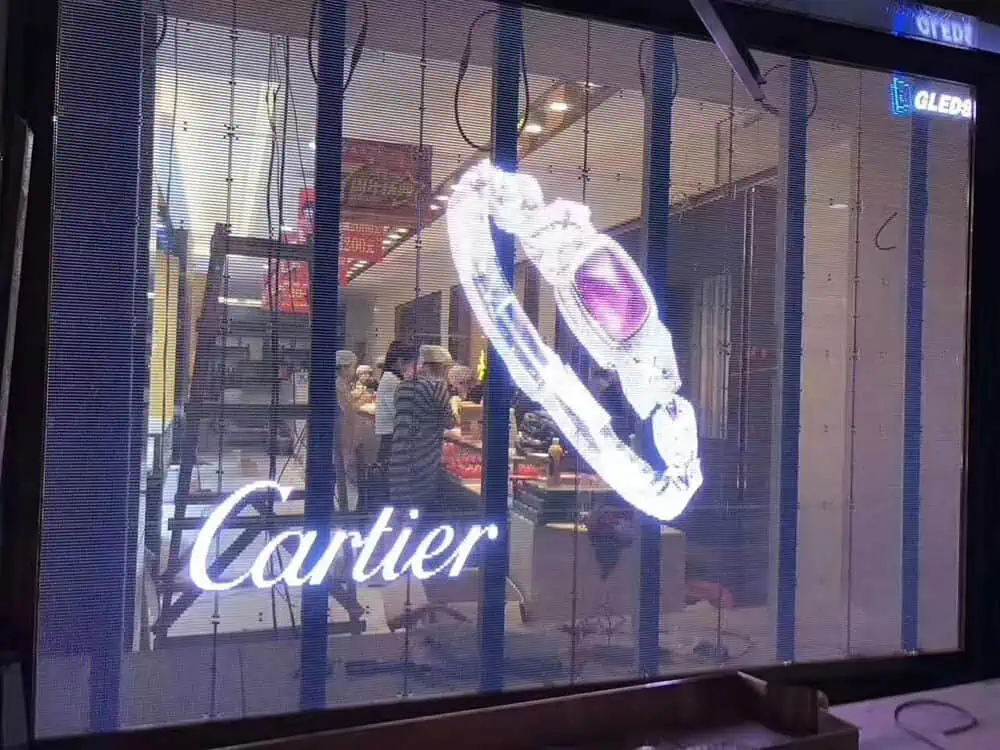
How to Install a Transparent LED Screen?
Installing a transparent LED screen can be a great way to add a modern touch to any setting. Here is a step-by-step suggestion on how to install one:
- Start by measuring the space where you want to install the screen. Ensure you have enough room for the screen and its frame.
- Prepare the area and ensure no obstructions or anything that could interfere with the installation process.
- Install the mounting brackets and secure them in place. Make sure the brackets are level and secure before continuing.
- Carefully attach the transparent LED screen to the mounting brackets. Then ensure secure placement so it won’t move.
- Connect all of the cables and wires needed to power up the screen. Make sure they are appropriately attached according to the manufacturer’s instructions.
- Turn on your transparent LED screen. Then adjust any settings as desired. Installation is done; enjoy your new display!

Applications of Transparent LED Screens
Transparent LED screens are great options for many applications. Here are just a few of the ways that you can use transparent LED screens:
- Retail Displays: Transparent LED screens provide eye-catching imagery. It is perfect for showcasing products in stores and other retail outlets. Retailers can create a truly captivating shopping experience. They do it by combining visuals with physical items.
- Art Installations: Transparent LED screens offer endless possibilities for creative art displays. These screens allow artists to explore new avenues of expression. It can be interactive light shows or futuristic murals.
- Advertising: Companies can use transparent LED screens to stand out from the competition. Also, they draw attention to their brand or products. These types of displays are perfect for significant events or high-traffic areas.
- Corporate Events: Transparent LED screens can help create an impressive atmosphere for corporate events. It can display relevant content such as company logos, messages, or videos. This adds a professional touch that makes any event more memorable and exciting.
- Trade Shows: Trade shows are the perfect opportunity to show off new products or services with the help of transparent LED screens. They can also create a stunning backdrop for presentations and panel discussions.
- Outdoor Billboards: With higher brightness and wider viewing angles, transparent LED screens can be seen even in direct sunlight, making them ideal for outdoor locations. They are made of glass and durable, and can withstand harsh weather conditions.
- Building Glass Curtain Wall: Transparent LED screens can be applied to the glass curtain wall of a building. It creates an eye-catching display that blends seamlessly with the exterior design. Due to their transparency, these screens don’t obstruct the view from inside or outside the building. It makes them an attractive addition to any project.
- Airports: Transparent LED screens provide a modern and sophisticated look at visibility and security. These screens can display gate information, flight delays, or even advertisements. They are also great for providing directions to travelers. It can be programmed to show different languages. Therefore, transparent LED screens are also energy-efficient and long-lasting, making them the perfect choice for busy airports.

Transparent LED Screen Vs. LED Glass
Transparent LED screens and LED glass can display visuals on a transparent surface. The other name for transparent LED screens is “transparent OLEDs.” They are made of light-emitting diodes (LEDs) on a thin film. The film is then mounted onto a transparent glass or plastic substrate. It allows for images and videos to be projected onto a transparent surface.
Meanwhile, LED glass is a type of electroluminescent technology. It uses light-emitting diodes (LEDs) embedded in the glass itself. The LEDs are wired to create patterns and shapes that display visuals on the glass. The transparent LED screens offer superior image quality compared to LED glass. The display resolution is higher with transparent LEDs due to their precise pixel placement. And it creates vibrant visuals with details that stand out more than those on an LED glass display.
Additionally, transparent LEDs are more accessible and cost-effective to install than LED glass. They do not require any wiring or structural changes. Regarding durability, LED glass has the advantage over transparent LEDs. Also, it is more resistant to external damage, such as scratches and impacts. Ultimately, transparent LED screens and LED glass have unique benefits and drawbacks. It depends on your particular needs. Either option can be an excellent choice for your digital display project.
Advantages of Transparent LED Screens Over Traditional LED Displays
Transparent LEDs are far better than traditional LED displays. How? Go through the below chart to know the reason-
| Features | Transparent LED | Traditional LED |
| Brightness | Significantly brighter; displays provide a crisp and clear image even in brightly lit areas. | Less bright than transparent LED screens and has less crisp images. |
| Durability | More durable and not affected by heat or dust buildup. | Less durable as they are prone to heat damage and dust build-up |
| Aesthetics | Sleek, modern look that blends in with the environment | Bulkier, more intrusive look |
| Cost | Affordable and cost-effective. | Expensive than transparent LED screens |
The traditional LED displays have a low viewing angle and poor image quality. It is also bulky. Furthermore, they are neither long-lasting nor cost-effective. On the other hand, transparent LED displays have a high viewing angle and better image quality. It has a standard, bland aesthetic. And it is also more durable and cost-effective. Concerning maintenance, transparent LED screens require more attention than traditional LED displays.
The Difference Between Opaque and Transparent LED Screens
Opaque and transparent LED screens are two types of LED displays with distinct features. The differences between them are as follows-
| Opaque LED Screens | Transparent LED Screens |
| Opaque LED screens do not allow light to pass through them. | Transparent LED screens allow light passage. |
| They provide a one-sided view. | These screens provide views from both sides. |
| Opaque LED screens are ideal for indoor uses. | Best for both outdoor applications. |
| They are best for places where the viewer is closer to the screen. | These LED screens support distant visibility. |
| Affordable in comparison to Transparent LED screens. | A bit expensive due to its advanced features. |
| Common Usage: Retail displays, Stage backdrops, and other similar applications. | Common Usage: Building facades, Billboards, and other similar applications. |
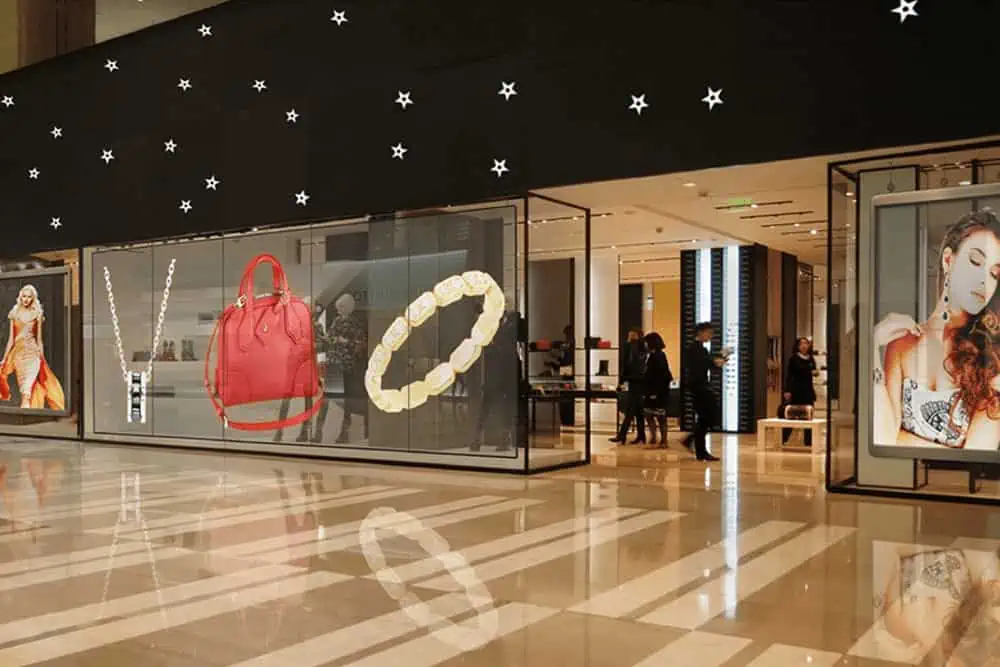
What to Consider When Choosing a Transparent LED Screen?
There are several aspects to consider when considering a transparent LED screen for your space.
Pixel Pitch – Pixel Density
Pixel pitch refers to the distance between two pixels. In comparison, pixel density is the number of pixels per square inch. A low pixel pitch and high pixel density will give you crystal images with more detail. This is especially important when using a transparent LED screen. Also, it can display images with brilliant clarity and vivid colors. You can create visually stunning displays that make an impact on viewers. Anyone can do it with the right combination of pixel pitch and pixel density.
Transparency Rate
The transparency rate determines the amount of light that passes through the screen and affects its performance. A higher transparency rate provides better visibility, increased brightness, and improved color accuracy. It also helps reduce eye strain, which is excellent for people who use the screen for long periods.
Additionally, a higher transparency rate can help reduce energy consumption. Since more light passes through the screen, less electricity is needed to make it work. As such, investing in a transparent LED screen with a high transparency rate is a wise choice. Consider this suggestion for anyone looking for an efficient and reliable display solution.
Brightness
A bright display ensures that the content is visible and legible, even in brightly lit environments. You can adjust brightness depending on the purpose of the display. Also, you can use it to make the content on display more visible and engaging. Moreover, brightness can help to enhance color contrast. That makes them stand out more clearly. As a result, images and text look sharper. And it works for digital signage applications excellently.
Additionally, a higher brightness level will also reduce eye strain. This makes it easier for viewers to watch the screen for long periods without discomfort. Therefore, investing in a transparent LED screen with higher brightness levels is essential to maximize your viewing experience.
Size
Transparent LED screens come in a variety of sizes. With some as small as 2 inches and others reaching several meters or more. Think carefully about the size you need. Also, how much space do you have available before making your purchase?
Resolution
The higher the resolution, the clearer the images appearing on the screen. Check the resolution of any transparent LED screen before buying it. So that you know it’s up to your standards.
Type of screen
Transparent LED screens come in active or passive-matrix varieties. So consider which kind is better for your project. Active-matrix screens generally offer sharper images. Meanwhile, passive-matrix screens are more affordable. They might have different image quality.
Quality and Reliability
Transparent LED screens require precision engineering and high-quality materials. It ensures that they work correctly and have a long lifespan. They can withstand the elements such as rain, wind, and UV rays. Also, it provides clear visuals at all times. If a transparent LED screen is not high-quality and reliable, it could fail prematurely. Or it can cause visual distortion under certain conditions. Therefore, investing in a quality transparent LED screen will deliver constant performance for years to come.
Efficiency in Installation and Maintenance Costs
Efficient installation and maintenance can result in significant cost savings over the long term. For example, advanced technology, such as automatic systems, can reduce labor costs. Furthermore, regular cleaning and inspections can help prevent costly repairs. It, too, could create replacements in the future. Therefore, you should do installation and maintenance processes with efficiency in mind to maximize cost savings.
Price Comparison
Different brands and models vary widely, so compare prices before making your final decision. This will help you to go for something that matches your budget.

Best Practices for Setting up and Maintaining Transparent LED Screens
Invest in High-Quality Transparent LED Screens
Quality is key in setting up and maintaining transparent LED screens. Investing in a reliable and durable product will ensure that your screens last and perform optimally.
Select the Right Location
Carefully consider the space in which you are putting the transparent LED screens. They should be placed in an area with plenty of natural light and a good line of sight.
Ensure Proper Ventilation
Make sure that the area surrounding your transparent LED screens is well-ventilated. It avoids overheating.
Check the Mounts
Make sure that the mounting hardware is suitable for the weight and size of your screen. Ensure that it is securely fastened. Also, use appropriate padding between the screen and the mount. It prevents any damage from vibrations.
Install Power Cables Safely
Pay close attention to power cable installation when setting up your screen. Securely attach them to avoid any trip hazards. And ensure that electrical outlets are safe and able to handle the wattage of your screen.
Connect to a Reliable Source
Always connect your transparent LED screen to a reliable source. Such as a UPS or generator in case of outages or power fluctuations. This will help ensure that your content is always displayed correctly.
Regularly Clean the Display
Cleaning the display regularly will help to ensure that your content is visible and apparent. Any dust or grime can obstruct visibility.
Monitor the Temperature
You should keep transparent LED screens at an optimal temperature range for optimal performance. So make sure to monitor the temperature closely to avoid any problems.
Minimize Glare
Glare from natural light or artificial lights can reduce visibility on the screen. Try to minimize this by using opaque curtains or shades where possible.
Use Anti-Glare Filters
Anti-glare filters can reduce reflection on your screen and improve visibility for viewers. It makes them a great addition to a transparent LED screen system.

FAQs
Yes, there are some limitations to using a transparent LED screen. For instance, the image quality is lower than that of other screens. So it may not be easy to view detaiLED images or text. Additionally, these screens are best viewed in darker rooms since they can be washed out by bright light. Moreover, the technology is still relatively new. As a result, the cost of installing and maintaining these screens is higher than other options.
You can use a transparent LED screen for both indoor and outdoor use. It depends on the model. For outdoor use, it is vital to pick a weather-resistant model. The design should be suitable specifically for outdoor use. For indoor use, any model should work.
The expected lifespan of a transparent LED screen depends on several factors. It includes the quality of the materials used and the environment in which they are kept. Generally, these screens can last up to 50,000 hours with proper maintenance.
Transparent LED screens display a variety of content. It includes videos, images, animations, text, and more. It is a great way to add an exciting element to any event or space. Depending on the model of the screen, the content can be either static or dynamic. These screens are great for creating interactive experiences. They allow viewers to see through the screen while still enjoying the visuals.
Yes, you may require additional equipment for a transparent LED screen. It depends on the type of display. Some screens may require additional audio components. This includes video controllers, cables, and other hardware to make sure the display is functioning properly. Additionally, some displays might need a power source and mounting system. This ensures that the attachment is secure.
The resolution of a transparent LED screen depends on the size, type, and model. Generally, they have resolutions ranging from Full HD (1920x1080p) up to Ultra HD (3840x2160p).
The amount of power a transparent LED screen consumes will depend on the size and resolution of the display. Generally speaking, transparent LED screens consume around 400–500 watts per square meter. But, of course, this can vary depending on the device.
The brightness of a transparent LED screen depends on the model and manufacturer. Generally speaking, most models are capable of producing incredibly bright visuals. It can often be brighter than other types of LED screens.
Yes, transparent LED screens require regular maintenance. To ensure they remain in optimal condition, it is crucial to clean the screens regularly. Also, you should check for any signs of damage or malfunction. Additionally, it is essential to check the connections and cables used with the screen to prevent problems.
Yes, there may be additional costs involved with operating a transparent LED screen. It depends on the size of your screen and the type of display you are using. You may need to purchase extra components too. This includes power supply, mounting hardware, cabling, and software. Also, you need to pay for installation and maintenance services if you need more expertise to install and maintain the screen yourself. Additionally, you might need to pay for electricity to keep the screen running.
Yes, there are some important safety considerations to be aware of when using a transparent LED screen. Always ensure that it is properly grounded and away from any sources of water or moisture. Do not touch any electrical components or wiring while operating the screen.
Yes, you can customize your transparent LED screen to suit your needs. Various options are available, including size, resolution, display type, and more. You can also choose from multiple colors and brightness levels to create the perfect look for any application.
Connecting multiple displays into one system with a transparent LED screen is possible. It depends on the type of transparent LED screen you have. You can connect more than one display to it. However, some of the screens may not support multiple connections. It’s best to check with your manufacturer to see what options are available for your particular setup.
Yes, you can control your transparent LED screen over Wi-Fi or Bluetooth. Many modern LED screens come with built-in Wi-Fi and Bluetooth connections. It allows you to easily connect your device to the screen and control it from a distance. You can also use an app on your phone or tablet to control the screen. It will give you even more flexibility in how you use the screen.

Conclusion
In conclusion, transparent LED screens are becoming more popular due to their versatile advantages. And they will make any space look modern, stylish, and aesthetically pleasing. Moreover, they are visually appealing, energy efficient, and long-lasting. In addition, they allow for more creative freedom and content access than traditional displays.
As long as the technology continues to improve, more applications will be available. It makes them even more desirable. Transparent LED screens are changing how we view our world and creating new opportunities for businesses and individuals.
LEDYi manufactures high-quality LED strips and LED neon flex. All of our products go through high-tech laboratories to ensure the utmost quality. Besides, we offer customizable options on our LED strips and neon flex. So, for premium LED strip and LED neon flex, contact LEDYi ASAP!
